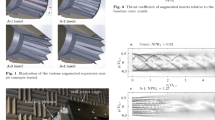Abstract
This paper addresses two important issues relevant to efficiency measurements in film-cooled annular cascades: the definition of the ideal flow to be used in loss calculation, and the measurements that are necessary for such loss calculation. The paper also addresses the question of the correct parameterisation of coolant density effects, showing that the momentum flux ratio, rather than the blowing rate, is the most appropriate parameter.
Experiments examining the effect of extensive aerofoil surface film cooling on the aerodynamic efficiency of an annular cascade of transonic nozzle guide vanes are reported. A dense foreign gas (SF6/Ar mixture) is used to simulate engine representative coolant-to-mainstream density ratios, momentum ratios and blowing rates under ambient temperature conditions. Experiments are also conducted with air coolant to study the effect of density ratio on efficiency. The flowfield measurements have been obtained using a four-hole pyramid probe in a short duration blowdown facility which correctly models engine Reynolds and Mach numbers.
This work compares the measured aerodynamic efficiencies of uncooled vanes with those which employ an extensive amount of cooling. The engine-representative cooling geometry investigated features 14 rows of cylindrical cooling holes, and a second geometry where 8 of these rows are replaced by holes having a fan-shaped exit. The effects of adding trailing edge slot ejection are also presented. By selectively blocking rows of holes, the cumulative effect on the mid-span efficiency of adding rows of cooling holes has also been determined.
Experimental results are presented as area traverse maps (total pressure, isentropic Mach number and flow angles), from which the relative changes in efficiency due to film cooling have been calculated. These calculations reveal that the presence of foreign-gas coolant from the cylindrical-hole geometry increases the aerodynamic loss (relative to the uncooled baseline) by 6.7%; and coolant from the fan-shaped holes increases the loss by 15%. The effects of different assumptions for the coolant total pressure are shown to significantly change the measured loss; if the loss measurements are based on the mainstream total pressure, rather than the total pressure in the coolant cavity, the respective increase in loss (relative to the uncooled baseline) of cylindrical and fan-shaped holes is 4.5% and 12.5%. Experimental data is compared with loss predictions using a Hartsel model.
Similar content being viewed by others
Author information
Authors and Affiliations
Additional information
Received: 4 December 1998/Accepted: 1 September 1999
Rights and permissions
About this article
Cite this article
Day, C., Oldfield, M. & Lock, G. Aerodynamic performance of an annular cascade of film cooled nozzle guide vanes under engine representative conditions. Experiments in Fluids 29, 117–129 (2000). https://doi.org/10.1007/s003489900062
Issue Date:
DOI: https://doi.org/10.1007/s003489900062




